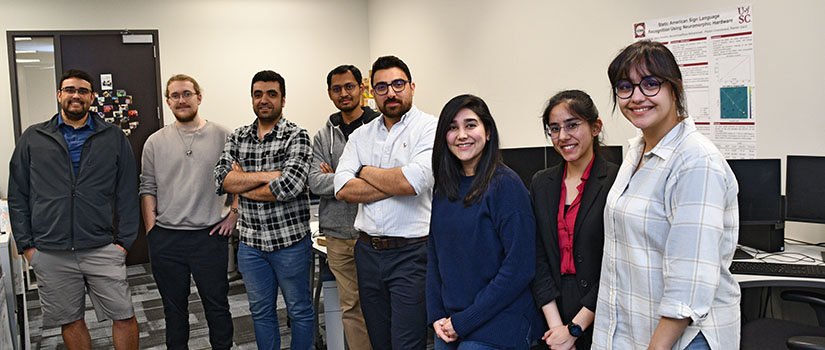Working on research projects, teaching and mentoring was initially not part of the plan for Computer Science and Engineering Assistant Professor Ramtin Zand. But it while working as a consultant for a startup company in Iran that he discovered more of an interest in research rather than industry.
Zand’s interest in engineering was a combination of enjoying math in high school and applied, hands-on projects. Even though he earned his bachelor’s and master’s degrees in electrical engineering, most of his work was focused on computer hardware design.
“I knew that fields like computer science and electrical engineering were where you could apply mathematical knowledge. I was excited about going in that direction because I knew the combination of liking math and project building would be interesting,” Zand says.
Zand considered a career in academia because he was familiar with industry and wanted to innovate and have more freedom to work on projects. He moved to the U.S. and earned his Ph.D. in computer engineering from the University of Central Florida, where he took advantage of every opportunity to teach a course or lab.
“My advisor, Dr. Ronald DeMara, was very supportive and he trained us to be professors. This was a dream opportunity after all my industry experience,” Zand says.
Zand’s research interests go back to his enjoyment of math and hands-on projects. He is director of the Intelligent Circuits, Architectures and Systems (iCAS) Lab. Zand’s team works on projects related to areas such as hardware, software and artificial intelligence. The iCAS Lab’s goal is to create smaller, faster and smarter computing systems to use in real-world applications without relying on large servers.
“I was always excited about theory and practical projects coming together, and that's what I'm doing now,” Zand says. “I like building systems that are useful and thought it would be interesting to bring an AI model to small devices. If we do that, then it can have a variety of uses because many applications need tiny devices connected to their systems. That was the vision for my lab.”
Contributing to Zand’s primary goal for the iCAS Lab are the other research focuses: neuromorphic computing, edge computing, in-memory processing and hardware design for AI.
“We try to solve problems in different ways, which is why we use the term heterogeneous, which means there is more than one solution. It’s a combination of solutions coming together to build a useful computing system,” Zand says.
Neuromorphic computing uses specialized hardware, such as AI chips and software algorithms, to simulate how the brain works to process data more efficiently. Some of his current projects include hand gesture recognition for American Sign Language.
“Neuromorphic combines machine learning and neuroscience. The idea is that if you make AI systems more inspired by the brain, there are benefits such as capturing temporal information, which are signals or data that is related to time,” Zand says. “Another benefit is event-based operation for battery-powered devices, which we want to run longer, so it conserves power by only processing data that's important.”
Edge computing refers to making more efficient machine learning models that can run on tiny devices. Zand has been working in this area since he started the iCAS Lab. One of the current projects is facial expression recognition using smaller neural networks and AI devices.
I like theoretical work, but to me, it's about bringing theory and application together.
- Ramtin Zand
In addition, Zand and his team’s work related to in-memory processing aims to construct a heterogeneous computer architecture to reduce the data movement between the memory and processor. Future projects include combining neuromorphic and edge computing for real time machine learning technology, which will build on current research.
“I think we have the foundation right now in terms of the skills needed in the lab to do these projects. My graduate students are brilliant and have the skills to develop these projects going forward,” Zand says. “We are excited that we'll have technologies that will be used in real world applications and are not just theoretical.”
Combined with research, Zand says that teaching and mentoring is one of the most satisfying aspects of his job. Over time, he sees changes and how students eventually contribute.
“I'm open to having undergraduate and graduate students without much research experience work for me. However, I have expectations and want them to be serious and disciplined about their work,” Zand says. “It's rewarding because of the impact I have in their lives and their contributions. I’ve learned a lot from them, and they make the lab a better place.”
Computer Engineering Ph.D. candidate Peyton Chandarana is a member of Zand’s research team and one of his mentees. He describes Zand as a monumental mentor in helping him inside and outside the lab to succeed in academic and research settings.
“He strives to be a great academic advisor and goes above and beyond to help his students challenge themselves and become the best versions of themselves,” Chandarana says. “I remember a specific quote when I first met him while taking his neuromorphic computing class. It was: ‘When you encounter challenges, enjoy the process of those challenges and enjoy the journey they take you on.’”
Zand believes that research and teaching are connected because he works on projects that are enjoyable, while mentoring students who are passionate about learning and research. In both aspects, he can have impacts to better the lives of students and society.
“I like theoretical work, but to me, it's about bringing theory and application together. I have a rule with the students in my team that they must demonstrate their work so people can relate to it,” Zand says. “Research is supposed to change. If not, then it’s either not being done correctly or it is irrelevant.”
